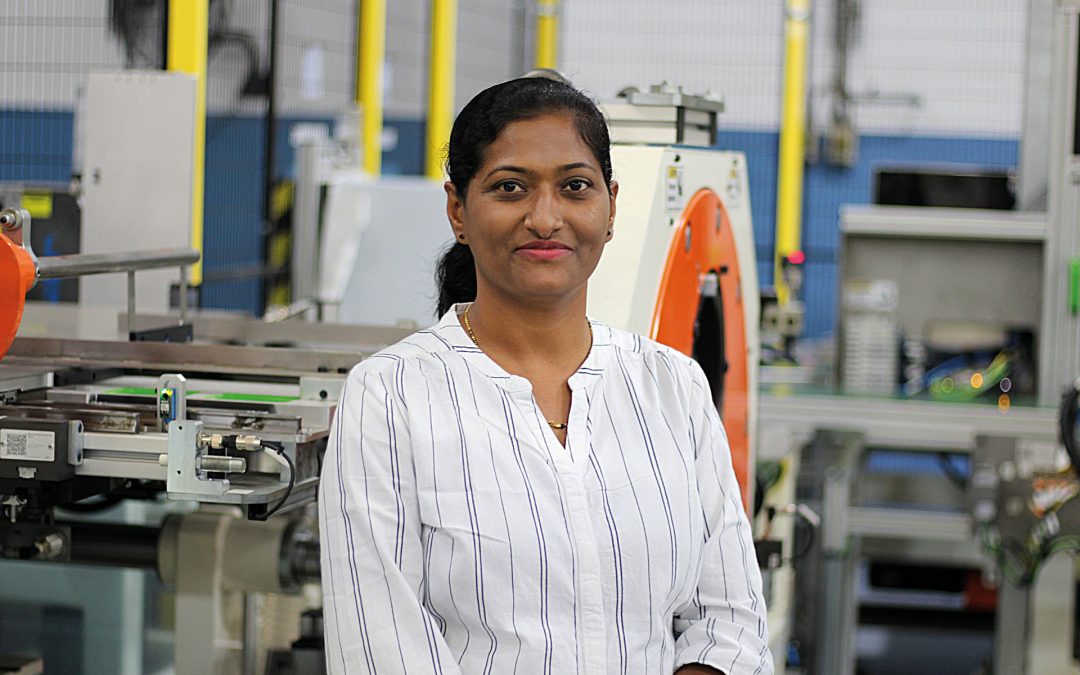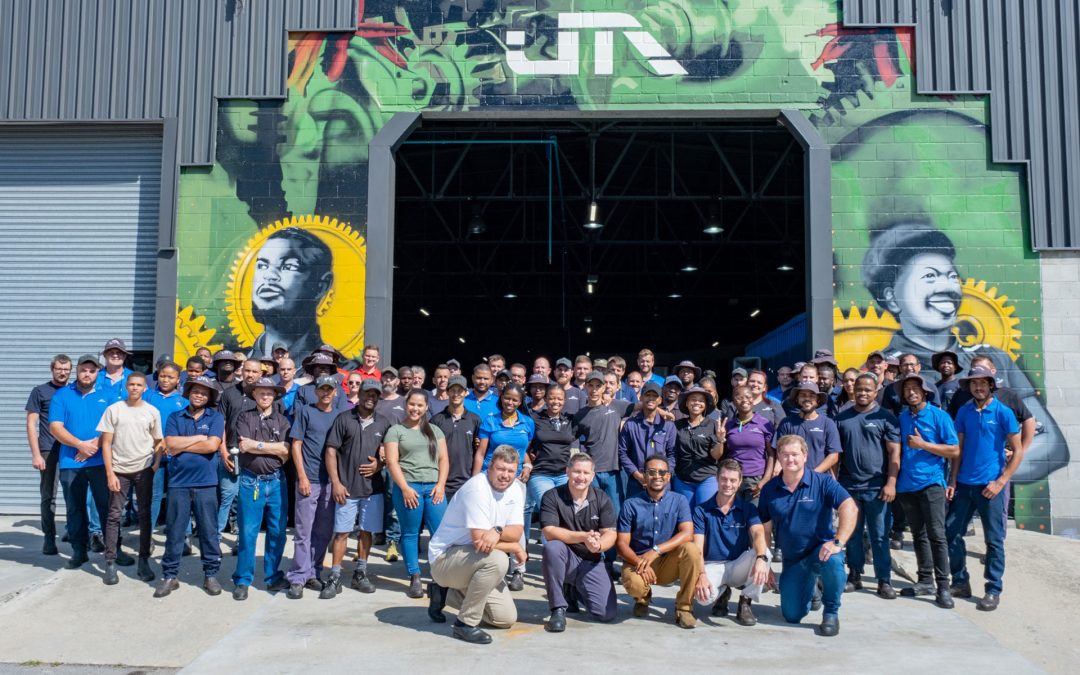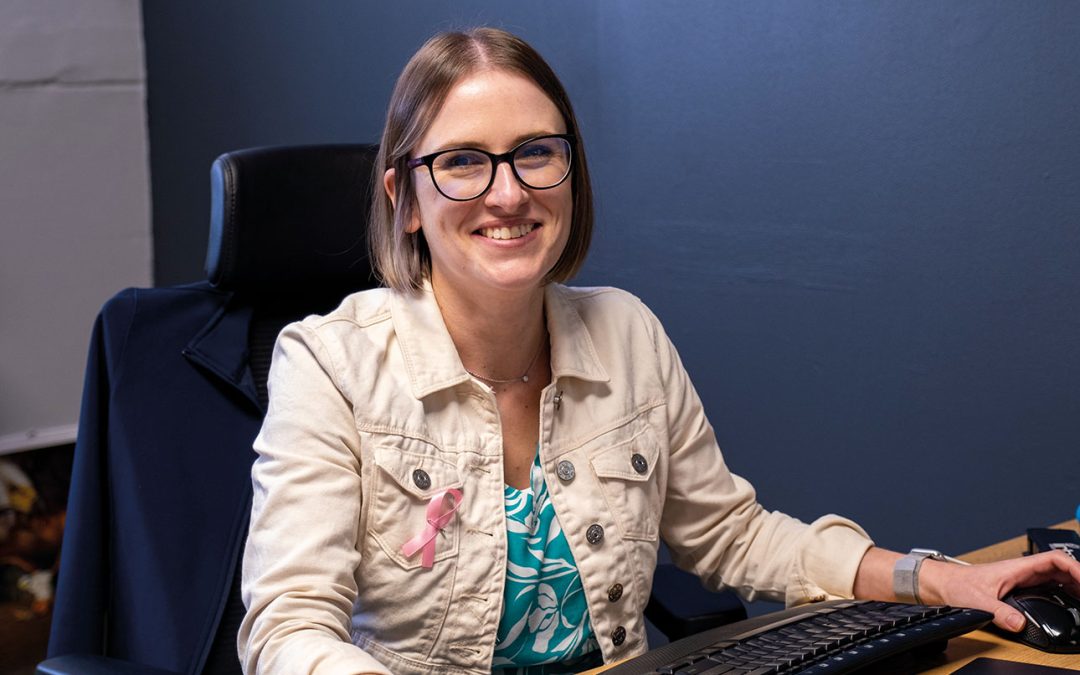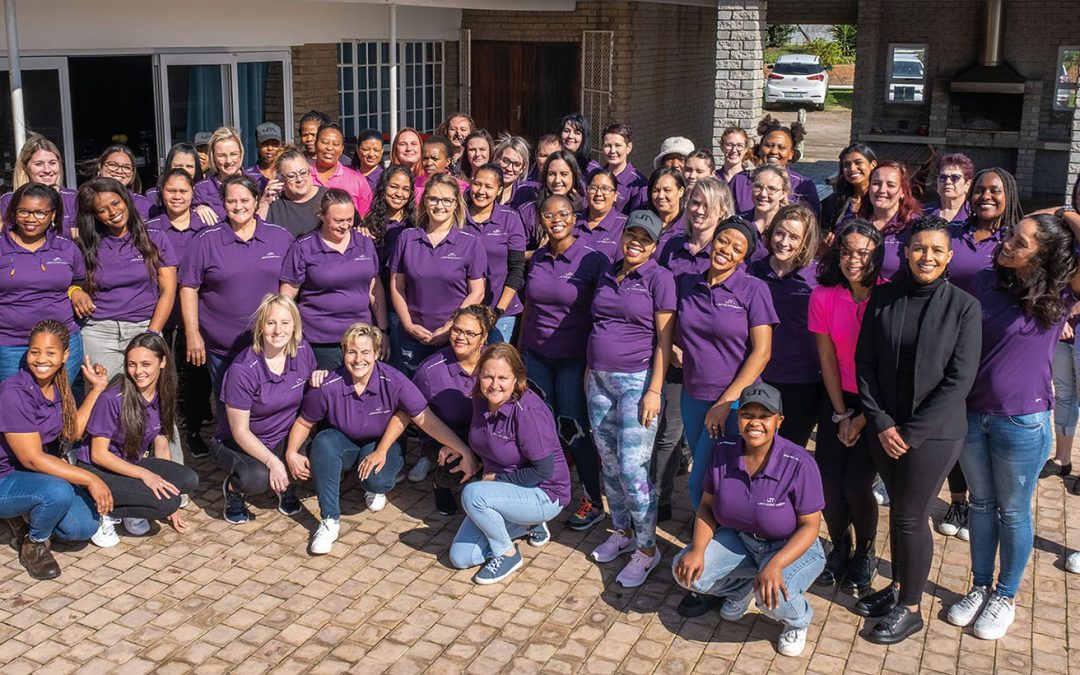
by NewsAdmin | Feb 7, 2023 | Jendamark News
Senior design engineer Reshma Jadhav recently travelled to South Africa where she spent two weeks learning the complexities of catalytic converters before taking up her new role as technical lead for Jendamark India’s canning division.
It has been a rapid rise for Jadhav, who joined Jendamark India just one year ago, after seven years with another automation company.
“At that company, the most complex project that I worked on was a cylinder head cam cover assembly line for a facility in China, which presented a number of challenges, including the cycle times on the line,” says Jadhav.
“Before I joined Jendamark India, I was never exposed to canning projects. So, my initial goal with this intensive training experience in South Africa was to learn all there is to know about the basics, including all tooling and facilities, so that I can impart this knowledge to my team in India.”
Jendamark’s South African team has been developing catalytic converter assembly facilities for almost three decades.
“When I started my training, I was given an induction by Alwyn Smit, who explained the entire design process flow, ensuring that I had a clear foundation. Then each member of the tooling team shared their personal process flow that they follow to ensure that a successful design is released every time,” explains Jadhav.
“I gained exposure to all the various checks that need to be done, the customer data that must be assessed, the tooling calculations that need to be done as well as the lessons learned from these calculations.
“I also learned about parametric modelling when designing multi-body assemblies, which is an incredibly helpful tool that can be used for designing canning tooling.”
Jadhav is excited to share all this newfound knowledge with her team, and see where improvements and increased efficiencies are possible.
She also takes back some fantastic travel memories such as taking time out to experience Gqeberha’s beautiful beaches, seaside flea markets, and game reserves with her colleagues.
“This opportunity is really exciting for me, and I accepted it with open arms. This is a fantastic opportunity for growth, and I will be eternally grateful for all the support and guidance. This new role is a way to develop my career in a well-established company and it’s a great position. I am excited to see what the future holds and looking forward to growing my team around me.”
Jadhav says, as a working mother, the flexibility that Jendamark offers with work-from-home initiatives makes it an adaptive environment that fits in with life’s daily challenges that can arise.
“The fact that Jendamark’s work globally is project-based means that every project we take on is challenging and different. No day is the same and I love coming up with innovative solutions to every one of the various challenges.”

by NewsAdmin | Jan 30, 2023 | Jendamark News
MAD MURAL: Jendamark’s manufacturing, assembly and design department celebrates the unveiling of their new mural, which honours the role of the artisan in industry, at the company headquarters in Gqeberha.
A LEADING South African tech company is spotlighting the country’s critical shortage of qualified artisans, with the hope of encouraging school leavers to pursue the much-needed technical trades.
According to Jendamark Automation, which builds and exports automotive component assembly systems for the global market, artisans are in high demand both locally and abroad, with good career prospects for those who progress successfully through vocational training programmes.
Last November, minister of higher education, science and innovation Blade Nzimande stated that South Africa needed at least 60% of school leavers to pursue artisan type training to meet the country’s demand for scarce skills.
Jendamark manufacturing and assembly manager Marinus van Rooyen said the company had noticed a worrying decline in the number of applications for advertised positions for artisans, especially among toolmakers.
“We are concerned about this trend and have found that this challenge is not unique to Jendamark, as our local and national manufacturing suppliers are experiencing the same frustration,” said Van Rooyen.
He said most matriculants viewed a university degree as the only qualification to aspire to but that many flourished in a more hands-on, practical learning environment.
“South Africa’s manufacturing sector can only grow if we have the talented engineers, artisans and technicians who have the skills to build and fix things,” said Van Rooyen.
Speaking at the official unveiling of a mural by Gqeberha-based artist Buntu Fihla at the company’s manufacturing and assembly hall, Van Rooyen said the aim of the mural was to instil pride among employees and to depict respect for the artisan.
“We want visiting school groups, students and employees to understand the value of having a trade and that it is a career path to be proud of, which offers many opportunities.
“For trade-tested artisans, the world is their oyster. There is a shortage of technical skills globally and we have found that many South Africans are being lured overseas by international recruiters.”
The country’s National Development Plan has a set target of turning out 30,000 artisans per annum by 2030. Current estimates suggest an average closer to 20,000, resulting in a shortage of what are categorised as “priority skills”.
Van Rooyen said Jendamark had been contributing to this skills development drive for the past decade by running its own in-house apprenticeship programme for mechanical fitters, electricians and toolmakers.
The four-year programme, which is overseen by MERSETA and endorsed by the Department of Higher Education and Training, has so far delivered an overall 98% pass rate for apprentices taking their trade test.
Qualified toolmaker and apprentice mentor Funeka Gusha, herself a product of the programme, is responsible for coaching Jendamark’s toolmaker apprentices through the work-based learning process.
“In becoming an artisan, you gain lots of skills and opportunities,” said Gusha.
“You’ll be able to earn an accredited Red Seal certificate, do better paid work, and, like me, may even be called upon to teach others.”
As a woman in a male-dominated industry, she said she was proud to have chosen a challenging career path and was pleased to share her expertise and experience with the young men and women coming through the ranks.
“I’m enjoying being a mentor. It has taught me a lot in terms of personal growth, patience and dealing with the different students. Seeing them working hard with determination inspires me. We’ve got one candidate who is preparing for his trade test right now and the dedication he is showing is amazing.”

by NewsAdmin | Jan 23, 2023 | Jendamark News
It has been a trial by fire for one of ODIN Manufacturing’s newest developers, Asanda Madikizela, who, fresh from university, has risen rapidly to the challenge of making ODIN Manager a reality.
Part of the ODIN Workstation offering, ODIN Manager is a web-based application that allows customers to configure their production processes and access data straight from the production line.
“My job involves both back-end and front-end development, which is challenging and exciting at the same time,” says Madikizela, who has been working on the app for the past year.
“There’s a satisfaction one gets when that piece of code not only works but has a great interface to go with it.”
Her focus is on adding new features, making continuous improvements to existing ones, and fixing bugs to maintain efficiency and usability.
“I’m currently being challenged to create a scheduler page, which is quite complex. The gist of it is that the page must allow the user to create a scheduled job for a particular substation and assign schedules to it, which can be executed in three different ways – time based, part count or shift based. These scheduled jobs contain a list of jobs that must be executed for the operations to be marked as complete.”
She says one of the most fun and challenging aspects is ensuring that the interface is smooth and efficient to allow the user to add all the necessary information without running into complications or being unable to use the system effectively.
“I’m still brainstorming how the UI will look for this one and it’s promising to be the most exciting yet.”
Of course, moving from the front end to the back end has not been without its challenges.
“I would say I’m most proud of the work I did with the operations page rewrite, which is the most recent feature I worked on. It made me sweat and cry, and yet it brought me so much satisfaction and growth.
“The operations page had a lot of interacting tables. I remember being stuck for over a week trying to figure out how to get the image coming from a separate tab to be displayed on a second tab without having to hit the refresh button. This was previously on a separate page, and all you had to do was click a button and it would redirect you.
“I remember getting to a point in the second week where I actually went to the bathroom and cried a bit. I thought to myself, ‘I’m going to be stuck on this for another week, aren’t I?’”
Madikizela says she grappled with the problem, which was with the initialisation of the page, for days on end until a simple answer presented itself.
“Imagine my shock when, after a long and tiring trial and error, the problem was solved by only calling a certain property on the tab that allows the pages to be initialised for the first time when the user clicks on the tab.
“But honestly, I learnt a lot during that process; the most important was patience, and to continue searching for the answer even when you feel like you’ve done everything that you can. Because there’s always one more thing you can try.”

by NewsAdmin | Jan 10, 2023 | Jendamark News
Jendamark Automation’s head of finance, Jacqui Nagle, is used to crunching big numbers and making tough business decisions. We asked her for an honest account of what it’s like to be a woman in the hot seat.
“I started at Jendamark on secondment in my final year of articles, and never looked back. The passion that runs through the veins of this company is what drew me to it and keeps challenging me every day.
In my experience, talking about women in the workplace can be a very taboo subject. We are in that awkward friend zone, where we are making progress, but not quite there yet globally.
I can honestly say that being a woman at Jendamark has never been particularly challenging for me. Yes, there have been the odd nuances and usual stereotypes from colleagues or service providers, but never have I felt the need to prove myself because of my gender. This has a lot to do with the directors and the culture they have created.
Don’t get me wrong; there are challenges. As I write this, while rocking my daughter to sleep after a long day*, I know that a lot of it has to do with previous generations not changing quickly enough and the knock-on effect this has had on the generation of women currently in leadership positions.
Women are often still expected to be the default parent and homemaker, and many companies are not in tune with a woman’s needs. A big fear among women is how we become mothers without compromising our careers.
I had an older man ask if I had been bothered by work during my maternity leave. When I said ‘No, not at all!’, he was surprised and exclaimed how lucky I was. This should not be considered luck. This is how it should be in every company in every country globally. Burnout is a serious risk among this generation of career-oriented women who are also becoming moms.
However, the new generation emerging from university is putting its collective foot down when it comes to gender roles. Seeing this, I know that in the near future the discussion around women in the workplace will no longer be necessary because it will no longer be of any relevance.
One of our management team’s directives for 2022 was to hire more women. This is not because we feel women need an advantage but rather because of the value we add, which is becoming increasingly clear globally.
Women are key role players when it comes to facilitating engagement, passion and empathy within the organisation and among colleagues. Nowadays, people want more out of their jobs. It’s not just about money or status but about the intrinsic value it adds to a person’s life.
Within Jendamark, our wellness days, talent pools and employee engagement initiatives are driven largely by our female colleagues. This is testament to our passion for the well-being of all people in the workplace.
It used to frustrate me that women were stereotyped as the more emotional sex, which translates to us often being labelled aggressive instead of assertive, or argumentative instead of honest. I’ve come to realise that it simply means our passion shines through, and for that we should be proud.
I often see social media posts by women saying, ‘Let’s be more like our male colleagues – don’t apologise when you’re late, no need to say thank you…’ But this, I believe, is more reflective of historical egos than gender.
I don’t agree with changing ourselves, as men or as women, for fear of judgement. Be professional, absolutely, but let us never lose our passion or enthusiasm for what we do!”
*Disclaimer: My husband is in the next room putting my son to bed, and he cooked supper, so I’m not that hard done by!

by NewsAdmin | Dec 12, 2022 | Jendamark News
Globally, the manufacturing sector is still male-dominated, and many companies struggle to attract skilled female candidates. But with digital technologies creating previously undreamed-of job possibilities, Jendamark is working hard to redress the gender imbalance.
The management teams in both India and South Africa have set clear targets to develop a diverse and inclusive workforce across all departments.
“In a perfect world, we would want a 50:50 ratio,” says Jendamark Automation human resources manager Mariette Geldenhuys.
“But we are hopeful that with the intake of more women through our skills development programmes, such as apprenticeships, we are actively working towards closing the gender gap, especially in the traditionally ‘male’ technical roles.”
The big picture
At Jendamark India, where women currently represent 7% of the workforce, the company has set an ambitious target of doubling this in the 2023 financial year. The aim is to employ at least one or two women in every department. “The advantages of having women in the workforce are manifold,” says JMKI’s head of HR, Pallavi Chavan.
“On a micro level, working women become financially independent and will have greater control over their own lives. This encourages women to stand against physical and emotional abuse, enabling them to handle social issues and pressures. At the macro level, greater participation of women in the workforce is good for the overall economy.”
In South Africa, women are one of the under-represented minority groups covered by the Employment Equity Act.
“In terms of affirmative action, we absolutely want to contribute to the success of various policies in this regard, but our aim is always to be an equal opportunity employer and appointments will be made according to experience and merit,” explains Geldenhuys, adding that female representation has grown from 16.9% to 24% in just two years.
Digital transformation
Both Chavan and Geldenhuys agree that the rise of Industry 4.0 technologies is transforming and creating new opportunities in the manufacturing space.
“In terms of innovation, women are adding great value, but a lot can be done to encourage young girls to enter into the fields of ICT, science and technology, which will enable them to apply for the various types of jobs that will inevitably be created by 4IR trends,” says Geldenhuys.
“It will become society’s duty to empower girls to be able to pursue these careers, specifically those in rural areas where access to technology is near non-existent.”
Employer of choice
According to the human resources professionals, diversity is becoming a strategic imperative for organisations looking to build a sustainable future. Women tend to bring a different dynamic to the workplace, with collaborative management styles and multi-tasking abilities, which fosters more balanced, motivated, and creative teams, helping the business to grow to its full potential.
“But this requires change from the top and, in Jendamark’s case, this change is being driven from exactly there. Being able to offer flexibility and a positive work-life balance by incorporating various policies and incentives will make a difference in attracting and retaining these skills,” Geldenhuys says.
Both agree that Jendamark’s flexible work-from-home policy, maternity leave benefits and empowerment programmes, such as self-defence training, are making a difference.
“Ultimately, our aim, when it comes to both male and female employees, is to be the employer of choice,” affirms Chavan.




